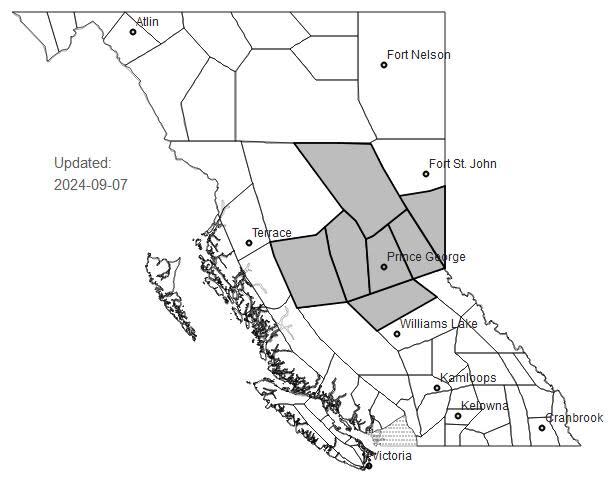


Residents in parts of central and northern B.C. are being warned about the extremely poor air quality caused by the smoke from out-of-control wildfires burning in the province’s Interior.
According to Environment Canada, Quesnel has a score of eight and Prince George a “+10” on the air quality health index (AQHI), indicating air pollution has increased health risks for people living there and in nearby areas.
“Best precaution to take is to stay away from these conditions if at all possible,” said Environment Canada meteorologist Philippe-Alain Bergeron.
It comes with growing wildfire activity at the Ootsa Lake complex, including the Sabina Lake blaze, west of Quesnel.
The fire has reached over 560 square kilometres in size since first being discovered on July 19 and is burning close to the Mount Wells fire, about 144 square kilometres south of Ootsa Lake.
The B.C. Wildfire Service says the two fires burning some 80 kilometres south of Burns Lake were at Rank 5 fire behaviour on Friday — the second-most extreme on the province’s fire scale.
“When fire behaviour is like this, responder safety is top priority,” the service said on social media Friday.
“[But now] crews have been reassessing and coming up with some more operational plans,” added fire information officer Morgan Blois.
The Regional District of Bulkley-Nechako says residents north of the lake should be prepared to leave on short notice.
“The [evacuation alert] is basically looking out in case [the fire] travels over the lake,” said district chair Mark Parker.
“It’s been extremely smoky through the whole Bulkley Valley.”

A smoky skies bulletin has been issued for the South Peace River, Cariboo region, Lake District, McGregor, Quesnel, Prince George, Stuart, Nechako and Williston. (Province of British Columbia)
The province also issued a smoky skies bulletin early Saturday morning for the South Peace River, Cariboo region, Lake District, McGregor, Quesnel and Prince George.
According to the province, air quality advisories are issued “when pollutant concentrations approach or exceed predetermined limits, or when degraded air quality episodes are expected to continue or worsen.”
There are currently about 220 active wildfires burning in the province, and the B.C. Wildfire Service says many fires are now in the “mop-up stage” as fall approaches.
But it says a spate of hot weather peaking on Friday means much of B.C. remains unseasonably dry and fuels “continue to be susceptible to ignition.”
The wildfire service says a fire in Tweedsmuir Provincial Park, also in Bulkley-Nechako, is “burning aggressively” to the northeast and smoke is visible in surrounding areas.
Moreover, dry and warm conditions have led to increased fire activity near the North Blackwater River, southeast of Ootsa Lake — forcing the Lhoosk’uz Dene Nation to issue an evacuation alert in the vicinity of the fire.
Environment Canada is forecasting cooler temperatures and some rain for parts of central B.C. but it will not provide relief for firefighters, says the wildfire service.
“With how dry the area is, and how dense the fuels are, a significant amount of rain would be need to help balance out the fire behaviour,” said Blois.